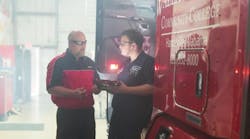Diesel tech school uses VR, money to attract students
The transportation sector, like all other sectors, is facing a labor shortage. This shortage is in the area of certified diesel technicians and mechanics able to service commercial trucks, buses, and diesel-powered transportation vehicles used for critical functions such as construction, farming, public transportation and emergency services.
As the industry, equipment and standards change, combined with the large number of technicians reaching retirement age, the industry will need 200,000 new technicians and mechanics over the next ten years. However, current diesel technology training programs are only producing about 3,500 graduates annually.
In Alabama, it is estimated that the state will need 3,000 trained diesel technicians over the next 6 years.
So, the state devised a program with the objective of attracting working adults to the field. One of the large initiatives, created in 2020, is the Diesel by Distance program which is based at Wallace State Community College in Alabama. The college is one of the largest in the state's education system and serves 6,000 students.
The program allows students to study from anywhere—even on the road, with live feedback and training from instructors—while they participate in paid apprenticeships that allow them to earn while they learn. Instruction occurs in an online format but includes competency demonstrations on campus scheduled at the student’s convenience, such as on weekends or evenings. Students earn multiple certificates or an Associate in Applied Science in diesel technology.
In April the program was enhanced as immersive learning startup TRANSFR, which will provide virtual reality (VR) to train those in the programs. “All skills gaps are local, and what we’ve heard clearly from industry is the need to augment traditional classroom instruction with the first-hand work experience that so often only on-the-job training can offer," Bharani Rajakumar, CEO of TRANSFR, said. As a true partnership between educators and industry leaders, Diesel by Distance has bridged the gap between work-based learning and classroom instruction, accelerating pathways to good-paying jobs for thousands of workers.
“The integration of simulation-based technology into this program is helping to generate new interest in the program and the careers in diesel tech, more broadly,” said Dr. Vicki Karolewics, president of Wallace State Community College.
Joining this effort is the Alabama Trucking Association. “Professional diesel technicians and professional truck drivers are the backbone of our industry,” Mark Colson, president of the Alabama Trucking Association, said. “Those with a diesel technician degree can find a job in almost any community in Alabama and can use that training to generate a strong income immediately. The diesel technician path also provides tremendous growth opportunities.”
Recruiting talent
Attracting students to this program in a multi-prong effort. “To recruit students, Wallace State is using social media, email, TV, and radio marketing to get the word out and are attending live events such as career fairs and college days,” Karolewics explained. “We have a strong relationship with local high schools and career schools, and we’ve been working closely with them to recruit dual enrollment students. Also, we are working with our industry partners to provide opportunities for their current employees who need or want additional training to join the program.“
Students can choose to pursue an associate degree, which is four semesters in length, or they can seek one of the short-term certificates, which are one semester in length. The cost for an associate degree is approximately $11,000 and is $2,000 for a short-term certificate. There are multiple forms of financial aid available to students, including scholarships and grants.
The goal of the program says Karolewics is to have every student placed in a job, whether it be a paid internship or apprenticeship, while they are still in the program. That way they are gaining on-the-job experience while learning, and when they graduate, they already have a job. Usually, employers will give the students a pay raise once they earn their degree or certificate.
The Diesel by Distance program has numerous industry partners—from national ones like Kubota, Caterpillar, and Snap-on, to those with offices located locally and regionally like Southland International, MyWay Transportation, and RE Garrison Trucking.
It is also important that we are communicating with people who have a high probability of success in the industry,” Colson said. “Specifically for diesel technicians, students that are juniors and seniors in High School, especially those already in Ag or career tech programs, are critical to educate on the availability of careers in trucking.”
Expanding the talent search
Looking for talent includes seeking out those who might not traditionally pursue these types of jobs. “Our research and data indicate women, minorities, and veterans are all groups of people that can “earn while they learn” getting a diesel technician certification and on the job training,” Colson said.
In fact, in 2020 part of the funding for the Diesel by Design program came from the National Institute for Women in Trades, Technology & Science to recruit and enroll aspiring female technicians.
Other funding in 2020 came from the Department of Labor’s WORC grant in partnership with the Appalachian Regional Commission. Through funding from the National Science Foundation’s Advanced Technological Education (ATE) program. And funding for the recent VR training came from the U.S. Department of Labor and the National Science Foundation federal and state agencies.
Funding for these types of programs is available since the earn and learn method has proven to be successful and Diesel by Distance is no exception with a 99.5% job replacement rate.
“Through this next-generation approach to technical training, we have an opportunity to meet a pressing need for employers, while getting those in search of work into secure and good-paying jobs,” Karolewics said. “The integration of simulation-based technology into this program is helping to generate new interest in the program and the careers in diesel tech, more broadly.”
This article originally appeared in MH&L.




